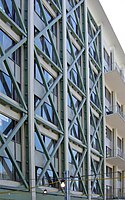
Photo from wikipedia
The evolution of microstructure of low alloy CrMo steel has a great influence on the mechanical properties. Three different tempering heat treatment conditions were made on the material, and the… Click to show full abstract
The evolution of microstructure of low alloy CrMo steel has a great influence on the mechanical properties. Three different tempering heat treatment conditions were made on the material, and the influence of the microstructure on the impact toughness under different test temperatures was studied. The type, morphology, size and distribution of the second phase will evolve with the change of tempering temperature and time. Impact energy of all samples increases gradually from the lower shelf to upper shelf with the testing temperature increasing. In the lower shelf, the fracture is controlled by the crack nucleation. In the ductile-to-brittle transition temperature (DBTT) range, the fracture is determined by the size of the initial crack initiating on the second phase. In the upper shelf, the cleavage fracture is controlled by the propagation of the carbide crack into continuous grains, and the critical event for fracture is the plasticity of the matrix. The scattering of impact energy in DBTT range is caused by the uneven distribution and size of the brittle second phase.
Journal Title: Proceedings of the Institution of Mechanical Engineers, Part L: Journal of Materials: Design and Applications
Year Published: 2021
Link to full text (if available)
Share on Social Media: Sign Up to like & get
recommendations!